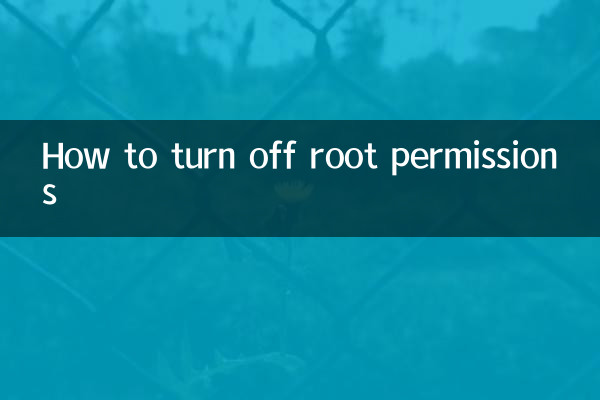Title: How to turn off root permissions
introduction:
In the Linux system, root authority is the highest level administrator authority and has complete control over the system. However, for security reasons, many users need to shut down in time after using root privileges to avoid misoperation or potential security risks. This article will introduce in detail how to turn off root permissions, and provide hot topics and hot content in the past 10 days as a reference.

1. How to turn off root permissions
Turning off root permissions can be achieved in the following ways:
| method | Operation steps |
|---|---|
| Use the exit command | Enter in the terminalexitor pressCtrl+DKey combination to exit the root session. |
| Switch back to normal user | usesu - usernamecommand to switch back to a normal user. |
| Disable root login | edit/etc/ssh/sshd_configfile, willPermitRootLoginset tono. |
| Use sudo instead of root | passsudoThe command performs administrator operations and avoids using the root account directly. |
2. Hot topics and content in the past 10 days
The following are the hot topics and hot content on the Internet in the past 10 days for readers’ reference:
| hot topics | heat index | Main content |
|---|---|---|
| New breakthroughs in AI technology | ★★★★★ | The application of artificial intelligence in medical, financial and other fields has made significant progress. |
| global climate change | ★★★★☆ | Extreme weather events occur frequently, and countries have stepped up discussions on climate policies. |
| Cryptocurrency volatility | ★★★☆☆ | Bitcoin prices fluctuated sharply, and market sentiment fluctuated greatly. |
| New product releases from technology companies | ★★★☆☆ | Several technology companies have announced the upcoming launch of a new generation of smart devices. |
3. Precautions for turning off root permissions
When turning off root permissions, you need to pay attention to the following points:
1.Confirm the operation is complete:Before exiting the root session, ensure that all operations requiring root privileges have been completed to avoid task failure due to exiting midway.
2.Back up important data:When modifying system configuration files (such as/etc/ssh/sshd_config), it is recommended to back up the original files first.
3.Check dependencies:Some services or scripts may require root permissions to run properly. After turning off root permissions, you need to check whether they are affected.
4. Summary
Turning off root permissions is an important step in Linux system security management. Through the methods introduced in this article, users can easily exit the root session or disable root login, thereby reducing system risks. At the same time, combined with recent hot topics, readers can learn about trends in science and technology, climate and other fields and broaden their knowledge.
Appendix: Frequently Asked Questions
Q1: How to re-enable root permissions after turning them off?
A1: Passedsudo su-orsudo -iCommand to regain root permissions, or modify/etc/ssh/sshd_configThe file allows root login again.
Q2: Will system updates be affected after root permission is turned off?
A2: No. Ordinary users can passsudo apt updateorsudo yum updateWait for the command to complete the system update.

check the details

check the details